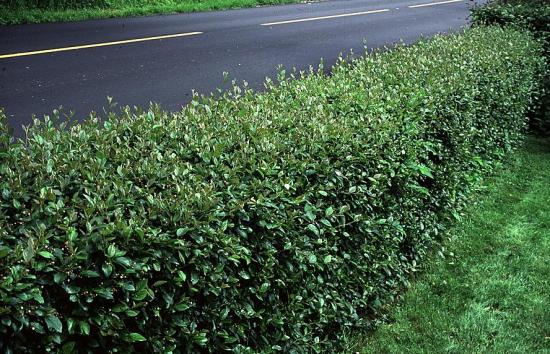We prefer fast growing shrubs and trees. Fast growing perennial hedge - selection of plants
The main task landscape design is to create a beautiful and functional site. Not the last role in its solution is played by fast-growing ornamental shrubs. Their planting allows you to create a picturesque outline of the garden and get the maximum benefit for the inhabitants of the local area.
Fast-growing ornamental shrubs: differences in growth rates
There are a lot of shrub plants used for planting in garden plots, squares and parks. Each species is distinguished by its decorative characteristics, crown height and width, and growth rate. According to the latter feature, they are divided into several groups depending on the size of the annual growth of shoots:
1) slow growing:: 15 to 25 cm

2) plants of moderate growth: 50 to 60 cm:

3) fast growing: 60 to 100 cm:
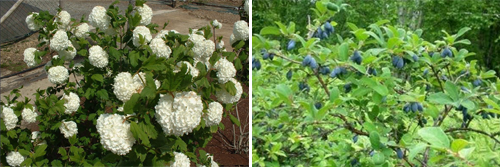

All ornamental shrubs grow in height and width. In some, the crown is spreading, in others, the shoots are located straight up, without deviating to the sides. When creating group combined plantings, hedges, it is recommended to take into account which group the plants belong to and what their structure is.
Slow growing crops are distinguished by the fact that they are able to create a dense dense crown. There are many fruit-bearing species in this group. Their berries are of great practical value. The aesthetic possibilities of such shrubs are expressed in color, shape, size and density of leaves on the shoots. All crops with a slight annual growth need pruning, and decorative crops need regular shearing, which is carried out 2-3 times per season. Then they look attractive and are able to decorate any site.
Plants of moderate growth boast beautiful foliage and excellent flowering. Almost all of them have a compact crown and do not need a summer haircut. The only condition is that after flowering it is necessary to remove dried buds to make room for next year's inflorescences. These shrubs form a large number of basal shoots, which must be removed in autumn or spring.
Excellent decorative properties have undersized fast-growing shrubs. Incredibly beautiful cotoneaster, horizontal and Dammer. They literally creep along the ground and are able to cover a significant area in a season due to the resulting half-meter growth.
Especially popular in decorative floriculture are fast-growing shrubs with an annual growth of up to 1 meter. These are very beautiful species with magnificent flowering. Their inflorescences can have a different shape: large balls (viburnum Buldenezh), panicles (panicled hydrangea), large bells (honeysuckle). Such plants look great in single plantings. They have beautiful greenery. Therefore, after the flowering period, they do not lose their attractiveness.
Giant shrubs, giving an annual growth of 2 meters or more, are distinguished by a lush crown and excellent flowering. Blossoming buds are wonderful flavors and honey plants. They are pruned in spring and autumn. This ennobles the plants and has a good effect on their decorative characteristics.
Fast-growing shrubs for hedges: what types are suitable for its construction
When creating a hedge, consider the size of shrubs, especially height and width. According to the first sign, decorative types are divided into
- high - 2-5 m: all shrubs with a very fast growth rate;
- medium - 1-2 m: fast and moderately growing species;
- low - from 0.5 to 1 m: creeping, creeping and stunted shrubs with moderate and slow annual growth.
Different types of ornamental shrubs have a certain natural crown shape:
- sprawling;
- compact;
- creeping.
Plants of the first and second species are suitable for hedges, since the latter do not create a natural obstacle, but play the role of a decorative carpet.
There are several rules for building green fences. The main condition is right choice plants and the possibility of their combination.
If a hedge is created from crops of one species, for example, hawthorn, barberry, brilliant cotoneaster, etc., only the species characteristics of the selected plant are taken into account.
If it is planned to build a combined green structure, the following indicators are taken into account:
- biological compatibility;
- rates of growth;
- shape and color of the crown;
- silhouette;
- flowering periods.
Do not plant crops of different growth rates in the same row. Those plants that develop faster will begin to suppress slow-growing ones. However, you can combine them when placed in parallel lines. For example, slow-growing boxwood will look great against tall lilac, jasmine, viburnum, and other fast-growing tall shrubs.
Lilac and hydrangea combine well when planted in the same row. These crops have lush greenery, large foliage and different flowering periods. In this way they complement the aesthetic properties of each other.
Next to white or variegated derain, its red counterpart looks impressive, as well as barberry colored in bright red, purple, coral colors. These plants are from the same group in terms of growth rates, so you can create an original hedge from them.
Curly and weaving species are suitable for a shrub fence. For example, honeysuckle honeysuckle, parthenocissus, ivy, roses. With little support, they create an insurmountable obstacle resembling an impregnable wall. At a height, the decorative properties of these plants are manifested to the greatest extent. Climbing roses and honeysuckle look great during the flowering period, when their shoots are abundantly covered with fragrant flowers. Wild grapes are especially spectacular in autumn, when they turn purplish red. And ivy can retain its green color even under snow.
When forming a hedge, monotony and monotony should not be allowed. ornamental shrubs designed to create a truly picturesque corner, so you should use them wisely.
Attention! Only today!
Arrangement suburban area, as a rule, begins with the designation of its boundaries. Many summer residents surround their plot with a fence, but there is another, more picturesque way to isolate themselves from the street - this is to plant and grow a hedge from clipped or free-growing shrubs.
And we want to offer you the best hedge plants so that you can choose from what is best to make a hedge for your site.
1. Spirea
They are excellent ornamental fast growing shrubs for hedges. In spring they bloom, and in autumn their leaves acquire a beautiful color. This hedge in the country grows 1 - 1.2 meters high. The shrub is easy to propagate with your own hands. The hedge grows winter-hardy and drought-resistant, the shrub does not get sick with anything, it looks beautiful both in summer and winter. However, spirea grows very strongly. To make the shrub look neat, it needs regular shearing, the frequency of which depends on the variety. With an irregular haircut, the lower part of the bush looks messy. shrubs for hedges.
2. Thuya
With proper care, thuja hedges retain an attractive appearance. all year round, such a hedge belongs to the evergreen. From thuja you can create a high and extremely dense green wall. The tree is shade-tolerant, frost-resistant and not very demanding on moisture and soil. For hedges, it is better to choose varieties of pyramidal thuja, for example, columnar varieties of western thuja "Brabant", "Smaragd", "Fastigiata".
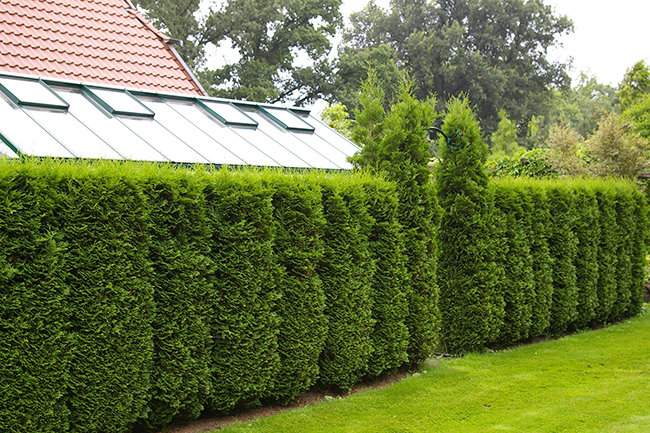
3. Snowberry
Perhaps these are the most unpretentious shrubs for hedges, low, grow up to 1 meter high. This shrub feels good even on a site with a high standing of groundwater. It is practically not damaged by diseases and pests. Perfectly tolerates pruning and shaping haircut. Increased resistance to gas and smoke allows the use of the snowberry to separate the car park from front areas and recreation areas.
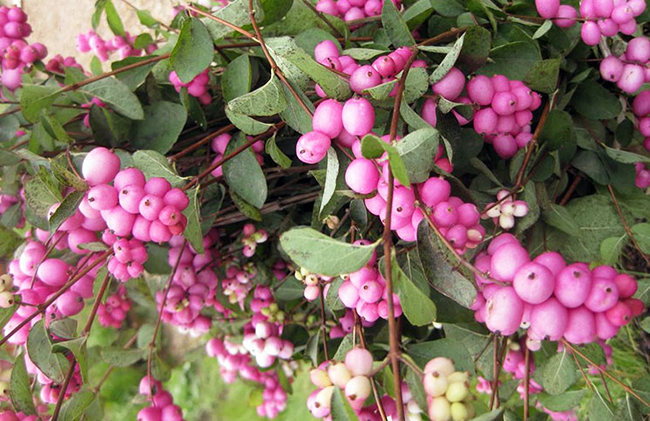
4. Cotoneaster
A very profitable option for a green hedge, as the plant tolerates a haircut well and "holds its shape." The shrub is resistant to adverse growing conditions, well adapted to climatic conditions. Bushes reluctantly, so it is better not to count on a quick result. Cotoneaster can be used in regular style gardens.

5. Bubble
A vigorous shrub that forms a dense hedge. Easily propagated by cuttings and grows quickly (40 cm wide and 40 cm high per year). Differs in unpretentiousness - frost-resistant, drought-resistant, can grow in shaded places, does not get sick. There are several showy cultivars with leaves ranging in color from golden to purple. The shrub takes up a lot of space, so you should not plant it in a small area.
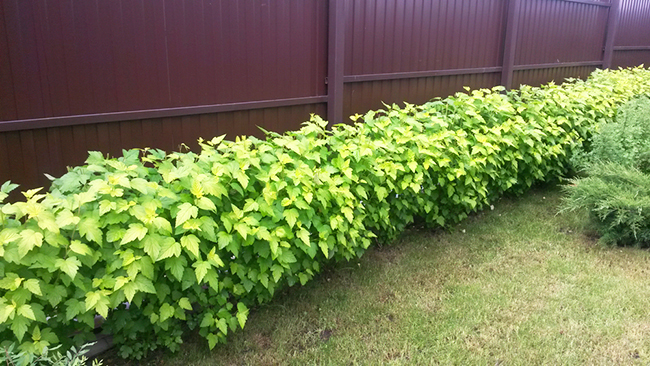
6. Barberry
Perfect for creating an impenetrable and impenetrable hedge in the country, you just need to choose tall varieties (for example, the Ottawa barberry "Superba" grows up to 3.5 meters in height). There are many hardy varieties of shrubs for hedges with beautiful foliage in different shades. One of the species - Thunberg's barberry - blooms and bears fruit in a haircut. Barberry absolutely cannot stand waterlogging and stagnant water.
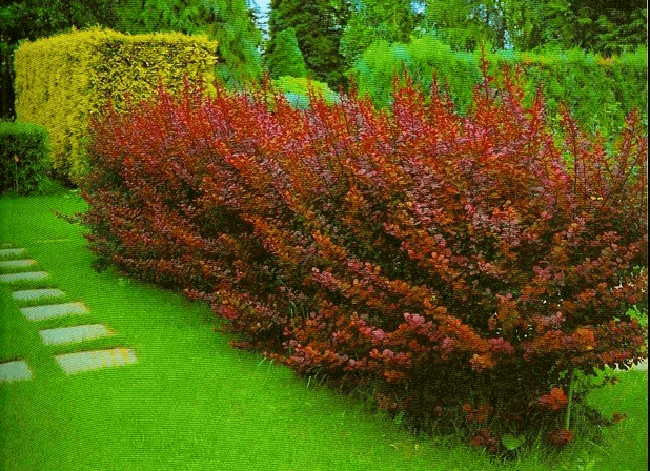
A fence made of brick, block, metal and even wood is sad and depressing. Perennial, fast growing hedge is an eco-friendly and attractive, but at the same time simple and inexpensive way of fencing. There are many types of plants that will become a shield on guard of personal space and protect from road dust and noise. One has only to study the growing conditions and the degree of their fastidiousness in order to choose the best specimen for individual preferences and the overall design of the site.
Blooming wall - a quick way to achieve what you want
It should be noted that it is impossible to achieve a dense crown in one year. Annuals are often used for this purpose, but the choice is complicated by the need for annual planting, as they dry out in autumn. It is better to choose flowering perennial vines, which, even if they are dormant in winter, but during active growth will not leave anyone indifferent. Every year they grow into a larger hat.
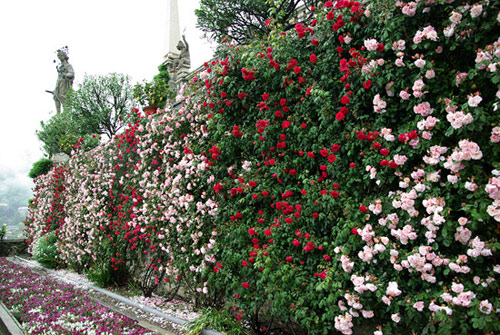
A variety of shades will allow you to create any design
Campsis - a bright fence without effort
Even a novice gardener can grow a fast-growing hedge from this perennial vine. It is so unpretentious that even an accidentally fallen shoot will sprout in a few days. There are only two types:
- kampsis rooting easy braids large surface, clinging to air roots, and more frost-resistant;
- kampsis grandiflora attracts with the size and brightness of the inflorescences, but supports should be installed for it. Suitable for growing in the southern regions, as it does not like long frosts.

Bright colors will attract all eyes
Kampsis without attention stretches up to 15 m, so it is better to forcefully form a wall out of it, for which several specimens are planted at a distance of 1 m from each other. Campsis prefers sunny places. Caring for a fast-growing hedge from this plant comes down to only periodic watering.
Fertilization is optional, but encouraged. Kampsis from July to September is covered with numerous bright, orange, red, yellow flowers. But the first year will delight only with the beauty of carved leaves, and will bloom profusely only the next season. Sheds leaves in winter. In severe frosts should be covered.
![]()
Roses will decorate any unsightly fence
Climbing roses - the desired result in one season
Roses are a definite hit for creating the fastest growing hedge. A variety of shades will allow you to make an original composition that cannot get bored. Unpretentiousness in care, good growth in the first year, abundant and long flowering - all this explains the choice of most gardeners.
Of course, you should not expect a dense crown in the first season, but roses can hide the yard from curious passers-by. For this purpose, only climbing species should be chosen, which initially require garters to the supports. To obtain the desired result, it is important to plant plants at a distance of 60 cm from each other. The height of adult specimens varies from 2.5 to 5 m. Young shoots are covered for the winter.
A photo of a hedge of fast-growing perennial roses will inspire any owner land plot.
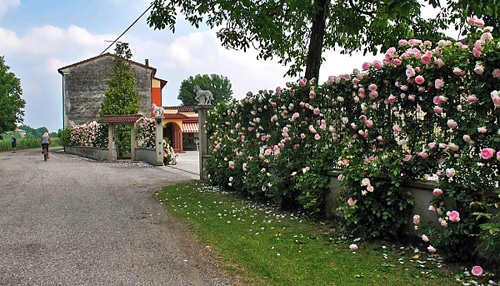
Climbing roses grow fast
Honeysuckle - variety from flowers to berries
A fast-growing hedge in the country can be created from several types of climbing honeysuckle, which differ different period flowering. Its shoots cling to any base and reach a height of 2 m. Honeysuckle is unpretentious in choosing soil and watering, but loves partial shade. Direct sunlight is contraindicated for her. Frost-resistant, withstands up to -40 degrees. In the first year it will create a wall with gaps, but it will quickly bloom.
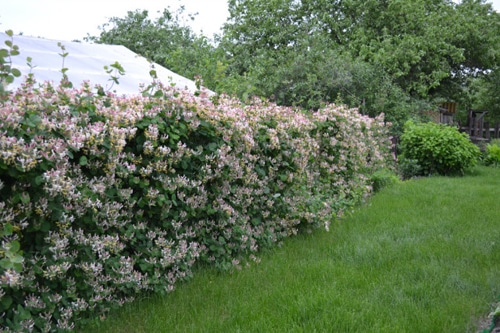
Curly honeysuckle grows better on a lattice fence
You can plant a fast-growing hedge from honeysuckle bushes. Their choice is justified if there is a desire to grow not only a beautiful wall, but to pamper the family healthy berries They are edible and very tasty. It bears fruit so abundantly that you can stock up on jam for the whole winter. It is better to plant curly specimens at a distance of 1 m, and shrubs - 60 cm from each other.

Edible honeysuckle fruit
How to create a dense green wall
To obtain a dense green crown, both deciduous and evergreen plants are selected. Often chosen for this purpose coniferous species but they take a very long time to grow. You can, of course, buy adult specimens in containers, but this option is expensive.
Barberry - beautiful and dangerous
It is possible to grow a live, fast-growing perennial barberry hedge only with sufficient care and attention. The unpretentious guardian will not only actively grow, but will also protect with its thorns from uninvited guests and neighboring animals. For dense growth, shrubs are planted at a distance of 20 cm, as well as in a checkerboard pattern.
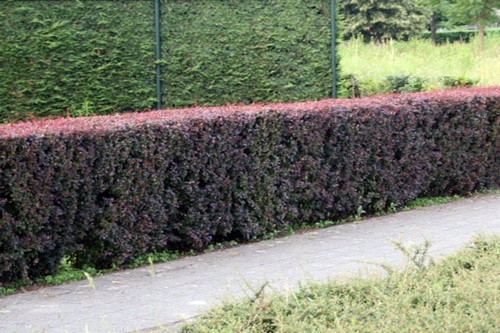
Beautiful when trimmed properly
The first year, it is important to cut off the side shoots, leaving 2-3 main branches. The second season, the branches are cut by a third before the buds begin to bloom. During the growth period, the soil is mulched. An adult barberry reaches a height of 1.5 m. It is important to form a shrub by cutting branches. Barberry flowers are not only attractive, but also smell good. The shrub is decorative in the autumn, and takes off the leaves for the winter.

A dense crown will grow over several years
Cotoneaster - evergreen or deciduous shrub
This plant will make a delightful fast growing perennial evergreen hedge. Different species can be both deciduous and evergreen. Gardeners choose for the original shiny foliage, as the flowers are small and do not add much charm. Feels good in the shade and in the sun. Frost-resistant. Mature plants reach a height of 2 m.
In the first year, the crown will not be very plentiful. Grows well for 3 years. Planted at a distance of 50 cm. It acquires a decorative look only with proper pruning, which is done in early spring before the buds open. Before watering a fast-growing cotoneaster hedge, remember that it is drought tolerant. Even in summer, it is watered once every 3 weeks or a month.
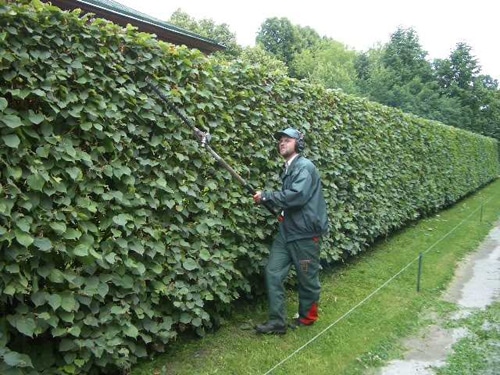
The plant is easy to shape
Privet - flowering shrub
Privet is a fast growing evergreen hedge shrub. There are deciduous species. At the beginning of summer it blooms, but not for long - only a month. Most species are not frost-resistant, therefore it takes root better in the southern regions. In the cold, the branches freeze to the ground and the privet dies. Young shoots grow rapidly, but adult shrubs reach no more than 2 m. Some species are only suitable for creating a low border, as they do not reach a height of more than 1 m. It lends itself well to pruning and shaping. It is easy to grow, as it is unpretentious and drought-resistant.
Gorgeous photos of a fast-growing perennial evergreen privet hedge confirm the need to choose this particular plant for decorating the fence.
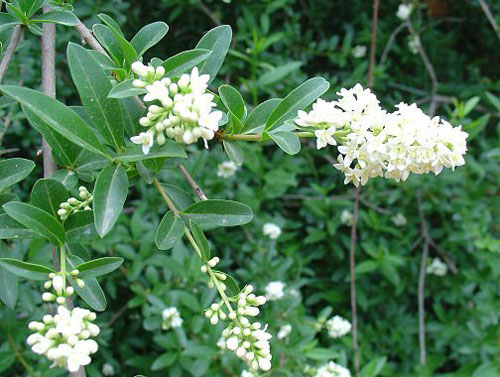
Flowers are not very attractive.
Before you grow a fast-growing hedge with your own hands, you should decide on the place and future height. The combination of a wall of tall plants in the background and blooming low ones in front looks original. The examples considered are only a small part of what can be implemented on your site.
Much is said about the benefits of hedges. But it seems to many owners of country estates and summer cottages that the process of forming an eco-fence takes a lot of time, and also requires a lot of attention. Of course, you will have to work hard. But in order for the fence to be full in a couple of years, you can pick up fast-growing perennials. It can be formed from shrubs, climbing plants, trees. And year-round decorativeness of a natural fence can be ensured if it is made from evergreen representatives of the flora. A fast-growing hedge will not only decorate the site, but also provide reliable protection from prying eyes and natural disasters.
Formation of a hedge: conditions and terms
For a natural hedge, you can choose different types fast growing plants, approximately the same in density of foliage or needles and height. To form it, you need to pay a lot of attention to it immediately after planting, as well as in the process of growth. This is due to the fact that for the same period of time some plants have time to stretch out, while others grow in width.
From fast-growing perennials, an excellent hedge can be formed in two years. It is better to select shrubs or trees such that, growing, they do not penetrate into neighboring areas.
Fast growing shrubs for live fencing
Shrub plants are the most popular material for hedges. And no wonder. Of them, you can make an impenetrable barbed fence, fruit-bearing, decorative, evergreen, which will fully perform all its functions. The choice is huge. It is only important to choose such plants that take root well in your area. But here everything is simple. Planting material must be purchased from local nurseries. Young shrubs by the time of planting in a permanent place will be fully acclimatized and adapted to local conditions. The most popular shrubs for fast growing hedges are:
Viburnum viburnum - an elegant decorationThis unpretentious shrub is represented by many varieties with bright golden or bright red foliage. Decorativeness is also due to the lush rounded shape of the crown. The plant prefers sunny open places. It also grows well in partial shade, but in this case the foliage loses its original color. The vesicle tolerates severe frosts and drought well, responds gratefully to a haircut, becoming even more magnificent and elegant.
Dogwood
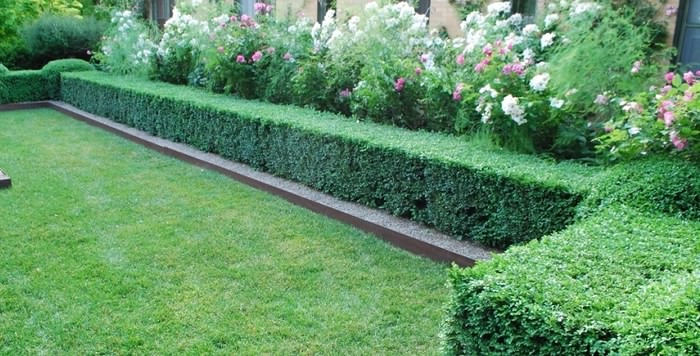 Hedge cotoneaster
Hedge cotoneaster The shrub grows rapidly, is characterized by unpretentiousness and shade tolerance. - A great option for outdoor fencing. Its decorative effect is most clearly manifested at the time of flowering. Dogwood fruits have healing properties. Therefore, compotes and jams are cooked from delicious berries, and they are also used in folk medicine. You can lay a dogwood hedge both in early spring and in autumn, before the start of frost. Plants planted in autumn are covered for the first wintering.
Turn
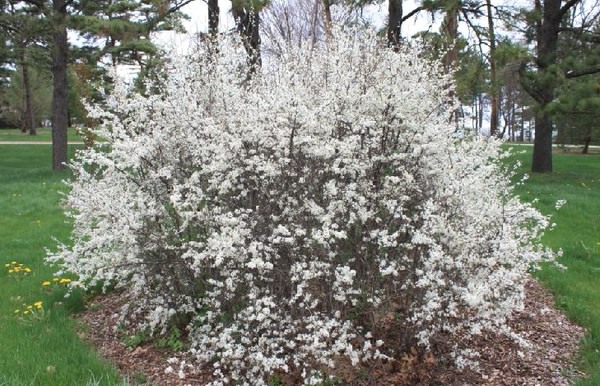 thorn bush
thorn bush Compact shrubs do not require frequent and careful pruning. The thorn makes a dense, impenetrable hedge. Berries have healing properties, but they can be eaten after frost. Until that time, they are tasteless and very knit in the mouth. In order for the shrub to begin to grow rapidly, it is cut at the level of 15 centimeters during planting. The haircut is repeated next year to give density to the hedge.
Barberry
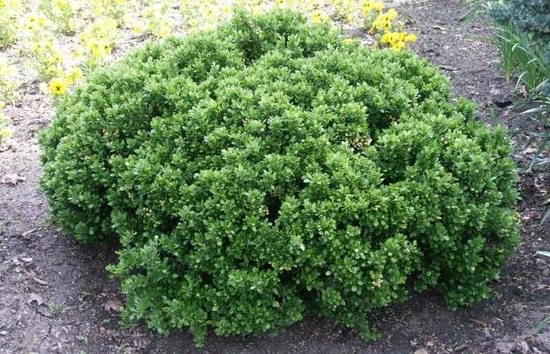 Barberry boxwood sheared
Barberry boxwood sheared The shrub is decorative, thanks to the bright foliage, but also prickly. It makes a dense impenetrable hedge. It tolerates dry periods well, but stagnant moisture can destroy it. Among the many varieties, you can choose those from which it is easy to form an eco-fence of the desired height. Barberry fruits are used in cooking.
Evergreens for fast growing hedges
A perennial evergreen hedge can be formed from deciduous or coniferous plants. It all depends on the design idea, the preferences of the site owner and his financial capabilities. Conifer hedges are distinguished by a special aristocracy. And here it is important to choose the right variety of trees or shrubs. The needles of some varieties love shade, while others prefer sunny open places. In addition, conifers do not grow well on clay soils and in places where ground water close to the earth's surface. The most popular plants for fast growing evergreen hedges are:
Norway spruce
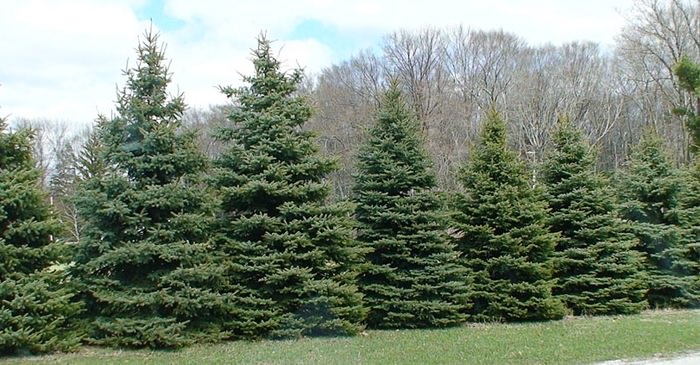
spruce hedge
This plant has many ornamental varieties. Most varieties have excellent branch density and feel comfortable in group plantings. perfectly adapted to harsh climatic conditions. evergreen shrub with glossy dense foliage can be a real decoration of your garden. Laurel cherries can be used to form a decorative natural hedge in the Mediterranean style. The height of the eco-fence can reach two meters. The plant requires regular shearing, as it quickly grows not only in height, but also grows rapidly in width.
Thuja western
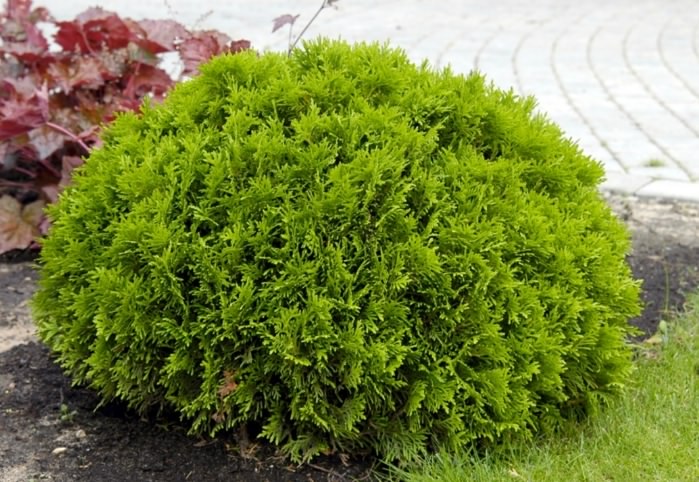
Spherical bush of thuja variety "Western Danica"
This plant produces hedges of exquisite beauty. It is only important to properly organize care. prefers sunny places, but at the same time its delicate scaly needles can get burned. The soil must be nutritious and moist. This plant tolerates frost and strong winds well. For better branching, it needs to be cut regularly.
Red cedar
 Juniperus Virginia "Glauka"
Juniperus Virginia "Glauka" This type of juniper has many varieties. In group plantings it feels good and looks especially decorative. This type of juniper is fast growing. Trees usually have a pyramidal low crown. In older specimens, it becomes sprawling. The bark does not rot.
Plants for climbing fast growing hedges
Perennial climbing hedge of fast-growing plants can be flowering, deciduous-decorative, evergreen. It all depends on the preferences of the owner of the site. As practice shows, the following types of plants are most often used for such eco-fences:
Campsis
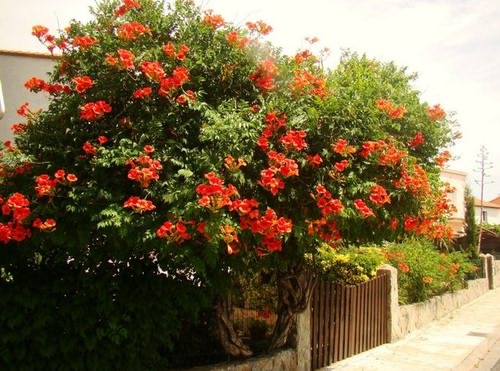 Blooming Kampsis bush
Blooming Kampsis bush From this fast-growing unpretentious vine, even a novice gardener can grow a chic hedge. Someone will prefer rooting kampsis, which quickly unwinds, clinging to the surface with air roots. It has good frost resistance. Campsis large-flowered is more decorative, but is suitable for growing in the southern regions, as it does not tolerate cold. It needs strong supports. If this plant is not given due attention, it will braid everything around very quickly. Therefore, you need to cut it in time, creating the desired shape of the hedge.
Honeysuckle
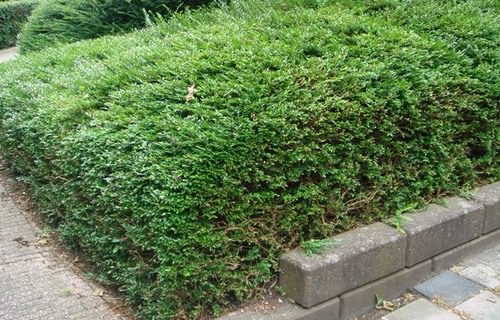 Honeysuckle brilliant
Honeysuckle brilliant To form a luxurious natural hedge, you can use several varieties of honeysuckle. This plant is undemanding to the composition and soil moisture, but prefers partial shade. It tolerates severe frosts well. In the first year after planting, the foliage will not completely close all the gaps on the wall. But all this is compensated by a beautiful flowering. Honeysuckle berries are not only tasty, but also very healthy.
climbing roses
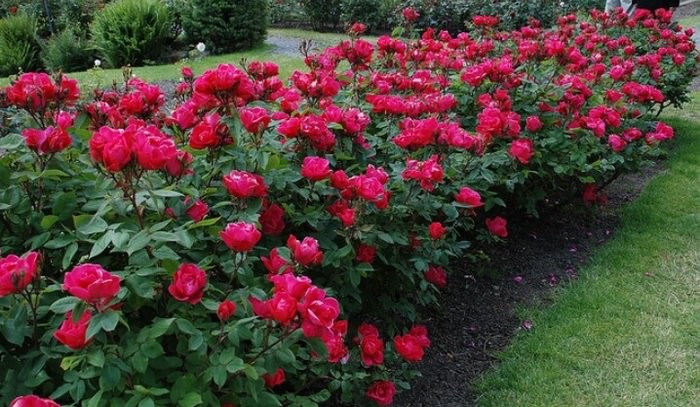
The desired effect will be achieved in the first season after planting. Among the many varieties, you can easily pick up plants whose flowers will delight the eye with bright juicy shades. Most gardeners love climbing roses for their unpretentiousness, ease of care, rapid growth and variety. colors. In the first year, the rose grows strongly, although it does not tightly cover the entire surface. But for the next season, the fence will completely hide the site from prying eyes.
With the help of fast-growing plants on your site, it is easy to realize any idea with a hedge. First you need to decide on the landing site and the height of the future eco-fence. And if you turn on your imagination, study the characteristics of the region and the adaptability of plants to local climatic conditions, then it is quite possible to do without the involvement of landscape design specialists.
It's no secret that now a fast-growing hedge can easily perform not only a protective function for the site, but also protect you from wind, dust, and also decorate it with your views. Such a fence will create more favorable conditions and a microclimate on your garden plot. We hope that our article will be useful for you!
Advantages, features of fast-growing shrubs
Fast growing shrubs have a number of features. It does not matter what type of shrub you prefer - coniferous, deciduous, it is important to choose a quality variety. Many fast-growing shrubs stand out for their height, this is their distinguishing characteristic.
The height of the bush reaches from two to five meters. The flowering of dogwood teaches for March - April and it lasts about two weeks, after flowering the leaves bloom. In open soil it bears abundant fruit, but in other areas it is also able to grow just as well. In spring or summer, shrubs are planted.
You can plant dogwood in the fall, but at least three weeks before frost. In the case of autumn planting, the leaves are removed from the dogwood. Bushes up to 2 years old are suitable for planting shrubs. For the winter, it is better to cover the bush with foliage.
Video about fast growing shrubs:
Barberry is an unpretentious shrub that can grow on any. It can withstand a little drought, but does not like stagnant water. This thorny shrub forms good hedge for the site. For hedges, you can use both tall and short varieties of barberry. In addition to all this, the barberry perfectly performs a decorative function. The barberry is most beautiful during the flowering period and at the time of fruit ripening. Barberry fruits can be eaten raw and for cooking and preservation.
The turn is an undemanding shrub. The bush grows up to three meters in height. It does not need careful pruning. The hedge of thorns grows thick. The fruits of the blackthorn are suitable for consumption, they break down after the onset of frost. During planting, the bushes are cut to 15 centimeters in height. This contributes to the rapid growth of the shrub. To make the fence impenetrable, pruning is repeated the next year. In the future, when cropping, the required height is simply maintained.
Fast growing shrub. Distinguish between black and red elderberry. Beautiful shrub that pleases in all seasons. In spring with its flowering, in summer - with a beautiful and lush crown, in autumn - with black or red fruits, depending on the species, in winter time- this is a crown in the form of a ball, if you formed it in time.
In the year when the shrub is planted during pruning, only two shoots are left on the seedling, and only later do the crown form.
Elderberry grows quite quickly, in three years it can outgrowths about two meters high. Elderberry is good option if necessary, create a fence as soon as possible. At the initial stages of growth, the seedling needs fertilizer, and in the future, he himself begins to enrich the earth with nitrogen.
Garden jasmine is also an unpretentious plant that will delight with its wonderful flowering and aroma. The shrub is able to grow in partial shade, but in this case the flowers grow slightly less. Jasmine takes root after planting quickly. Plant cuttings. Does not require abundant watering, only in the case of a very dry summer.
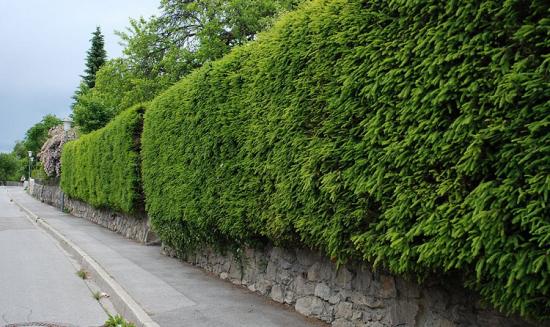
After planting, the shrubs quickly take root. able to form a hedge. Plant it at a distance of at least a meter. Because of its fast jasmine needs timely pruning. Pruning is done after flowering. The plant is pruned every year. In case of freezing of branches after winter, they are pruned, but more than three cannot be. Terry jasmine is less stable in winter, so it requires shelter for the winter.
Based on the above, we can highlight the main thing. Fast growing shrubs are great for making hedges that can be formed in a couple of years. In addition, most of the plants bear fruits that are suitable for consumption. And also the advantage of fast-growing shrubs is that they are not demanding in care. Thank you for your attention and wish you success in planting fast-growing shrubs!
